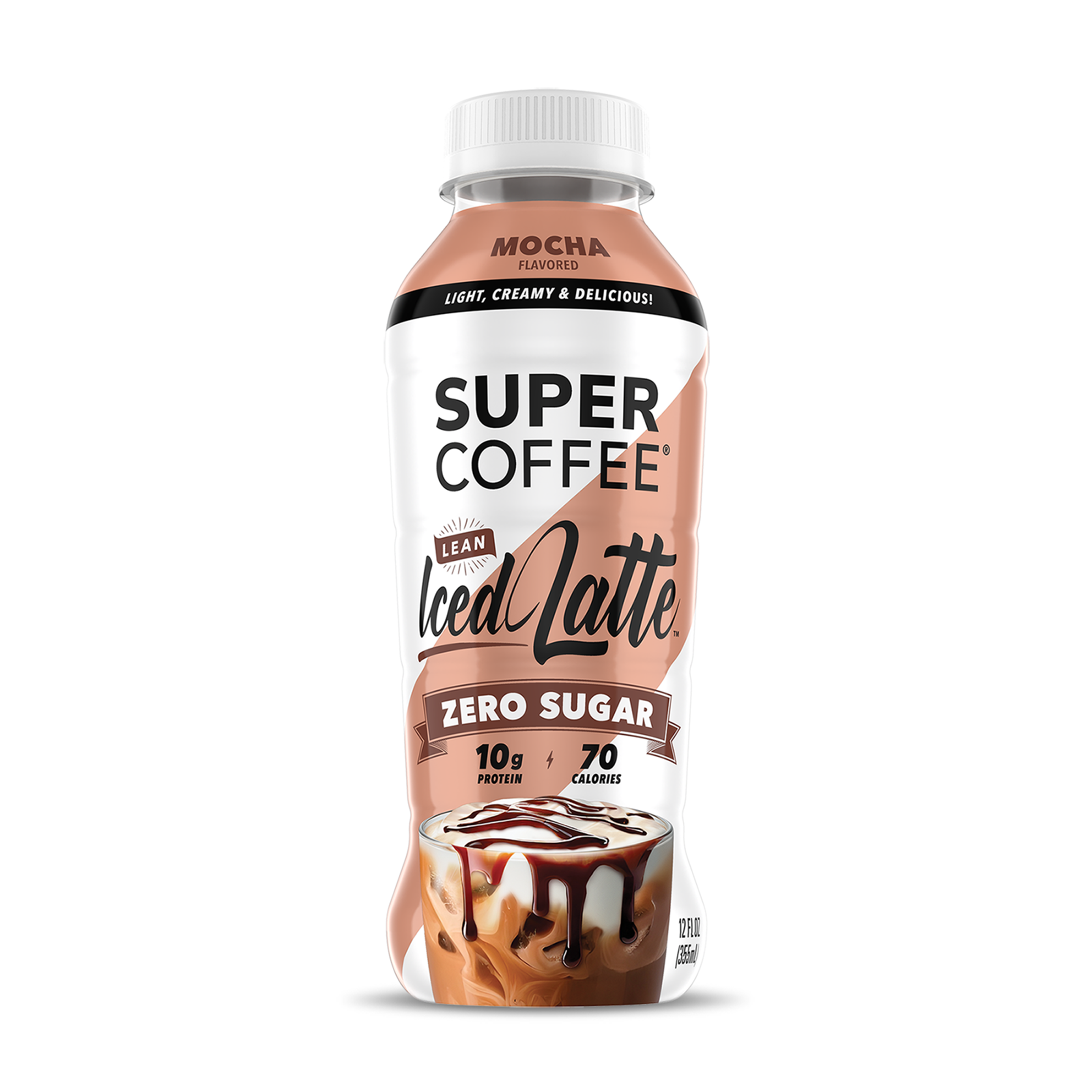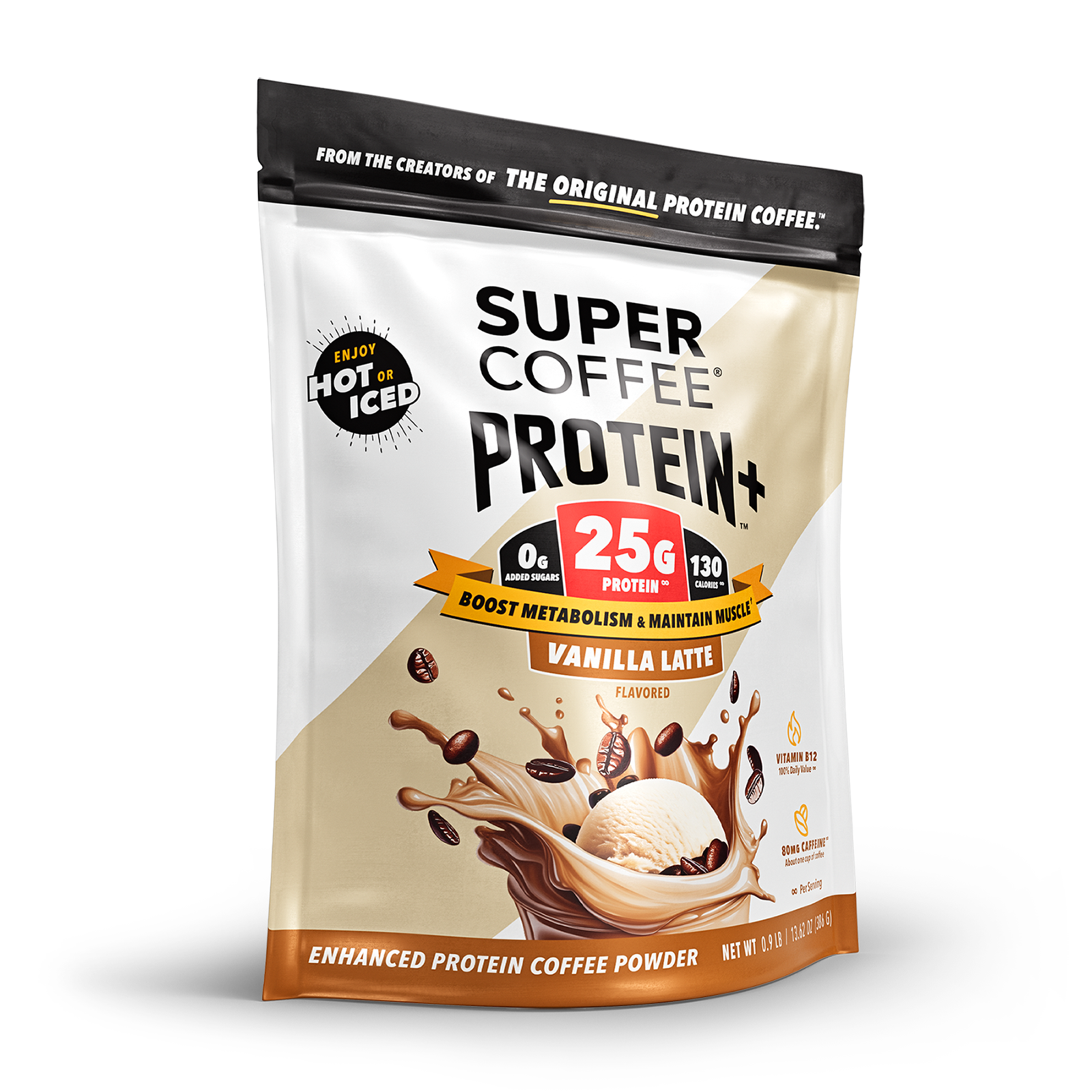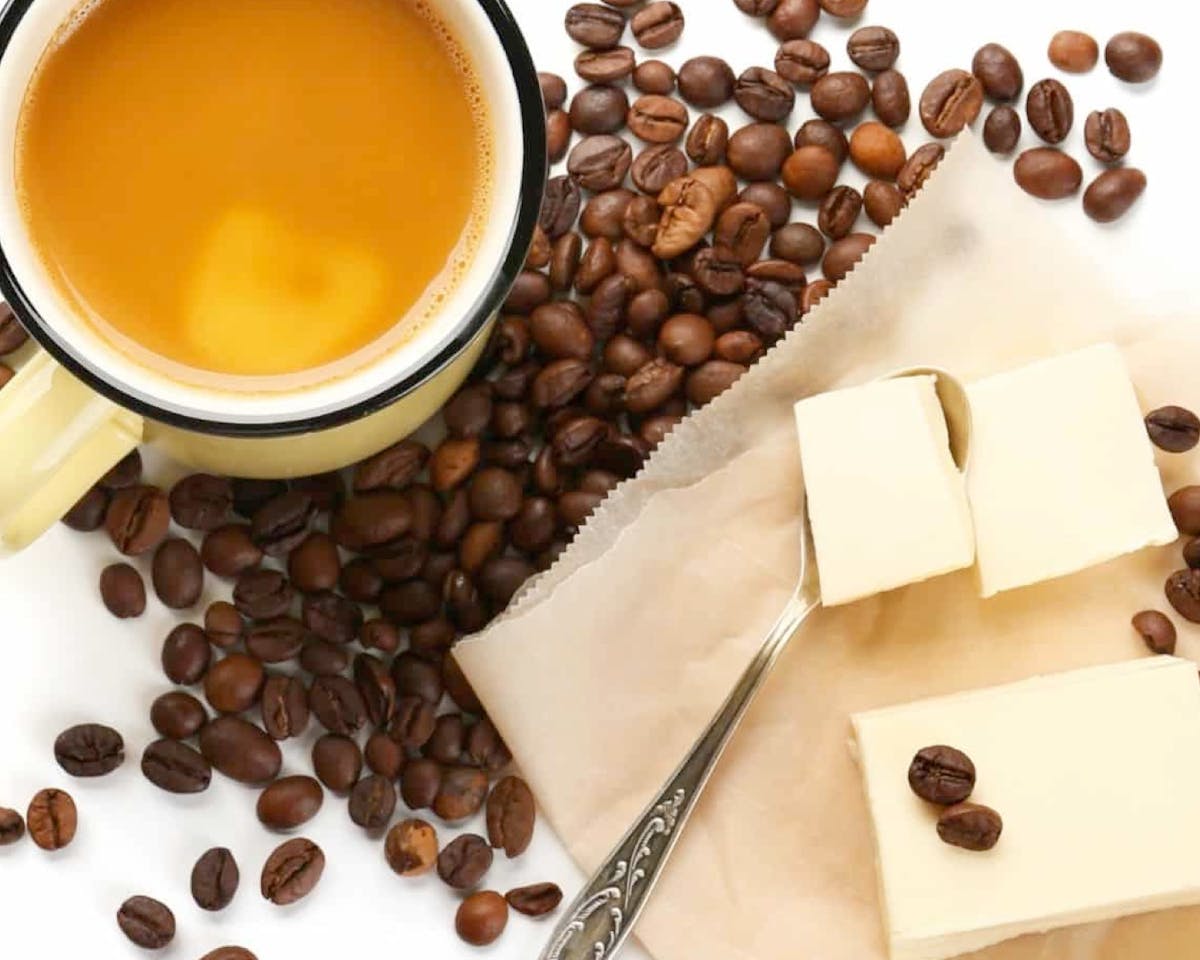Your cart is empty
You probably learned about oxymorons when you were in school. You might have remembered them because oxymoron is a funny-sound word that includes the word “moron.”
Jumbo shrimp. True fiction. Freezer burn. Working vacation. Only choice. They’re all oxymorons – figures of speech containing two contradictory words side-by-side, which have taken on their own literary meaning.
Butter coffee isn’t an oxymoron, because butter and coffee aren’t contradictory words. They’re just two words that don’t seem like they should go together, like hamburger sundae or anchovy honey.
Actually, butter and coffee don’t just together; they’re key ingredients in one of the hottest drinks of the 21st century. You may know butter coffee by its more common names, keto coffee or “bulletproof coffee,” and it’s a staple for those following the ketogenic diet.
In a bit, we’ll explain the reasons why bulletproof coffee is so popular among those on a low-carb, high-fat diet. First, though, we have to correct a commonly-believed myth. Butter coffee wasn’t invented in 2009, after the self-described biohacker behind the Bulletproof Diet went hiking in Tibet.
Butter coffee was around for years before that. About 1200 years before that, to be precise.
Where Did Butter Coffee Come From?
The history is a little muddled, but for good reason; not only was there no internet 1200 years ago, there were no printing presses, either. Here’s a good approximation, though.
The stimulant potential of coffee was first “discovered” in either Yemen or Ethiopia, sometime around the 9th century. We’re more interested in Ethiopia, however. That’s where it’s believed people began mixing ground coffee with ghee, a type of highly-clarified butter that had the milk solids and water removed. Ghee was a common food during that period.
The reason for mixing caffeine-heavy coffee and ghee is obvious, when you think about it. The mixture was easy to carry around, and could be used as a stimulant during long treks. And since ghee slowed the delivery of caffeine to the brain, the extra energy levels could last for hours.
Over time, Ethiopian’s Gurage people began mixing ghee, along with honey and salt, into their brewed coffee. And they weren’t alone.
Populations throughout the Himalayas, where long treks through challenging altitudes were an everyday fact of life, discovered the benefits of mixing butter (or ghee) with coffee during the Middle Ages. It became a popular, energizing morning brew, as did the butter tea believed to have originated in Tibet. It’s also traditional to sauté coffee beans in butter in several Asian nations.
So now that it’s clear that butter coffee is really an ancient tradition, we can go back to that story about a biohacker’s trip to Tibet.
How Butter Coffee Became “Bulletproof Coffee”
Dave Asprey, the Bulletproof coffee guru, did indeed take a hiking trip through Tibet about ten years ago. As he tells it, he sampled Tibetan yak butter tea on his journey, and remembered it when he got back to the States.
Asprey’s background was primarily in IT and Silicon Valley startups, but he had apparently been interested in the profit potential of coffee since the mid-1990s when he sold caffeine t-shirts on Usenet newsgroups. He published his coffee-with-butter recipe on his own website in 2009, began selling “low-mold coffee beans” and related products on his site a short time later, and started creating companies and trademarking his “Bulletproof” brand around 2013.
The timing was perfect. Asprey was pushing his recipe and selling his products right around the same time that the keto diet exploded into Western consciousness.
The Keto Diet and Butter Coffee: A Marriage Made In Fat-Loss Heaven
Low-carbohydrate diets have been regularly used as a treatment for certain forms of epilepsy since the 1920s; they were a refinement of the previous treatment, intermittent fasting. And there’s some evidence that variations on the diet were used for the same purpose as far back as 500 B.C.
Dr. Robert Atkins (of Atkins diet fame) first suggested high-fat, low-carb eating plans in 1972, and late-20th century liquid diets (including one pushed by Oprah) were based on the same principles. The low-carb Atkins diet received new attention in the early 21st century.
But what became the keto diet wasn’t well-known until 2013, when a study was conducted at San Francisco’s Gladstone Institute. It detailed findings that some ketone bodies, the alternate energy source created when the body is deprived of carbs, might help in the treatment of medical conditions and illnesses including heart disease and cancer, and might even slow the aging process.
The news kick-started a frenzy in traditional media and on social media: weight loss and health benefits? That’s the perfect recipe for creating a fad diet – and if it really works, that’s even better. Keto became the subject of enormous worldwide publicity, with millions eventually trying the keto diet.
It was also the perfect time for Asprey to expand his growing companies, because his products centered on coffee that fit right into keto guidelines (and paleo diet guidelines, for that matter).
What are those guidelines that match well with the “bulletproof” approach? Glad you asked.
In ketogenic eating plans, carb consumption is kept to very low levels, as low as 20 net carbs (total carbs minus fiber) per day. Carbs like bread, pasta and bakery products are mostly replaced by high-quality, healthy fats.
The reason is simple: the body and brain use glucose as their energy source, and glucose is produced by burning the carbohydrates we eat. When the body doesn’t have enough carbs, it has to find a different energy source. What it does is enter a metabolic state called ketosis; in ketosis, the body burns stored body fat, to produce molecules known as ketone bodies (ketones for short) that can be used for energy.
Fat-burning, of course, is one of the keys to weight loss – so as long as a dieter keeps carb consumption very low and stays in ketosis, they continue to lose weight.
How does butter coffee – or as Asprey wants us to call it, bulletproof coffee – fit into the picture?
It contains black coffee, of course; the scientific evidence is murky at best, but some believe that caffeine helps with weight loss. It contains unsalted grass-fed butter (high in Omega-3 fatty acids) or ghee, sources of very healthy fats. And it also contains something called MCT oil, which can be extremely helpful for a keto dieter who is trying to stay in ketosis.
Why Is MCT Oil in Butter Coffee?
Until fairly recently, you couldn’t find MCT oil in your local grocery store or even on Amazon. Today, it’s a very big deal. MCT stands for medium-chain triglycerides, and the name describes the structure of these types of fat.
Here’s just enough detail to explain MCT oil while (hopefully) not making you confused or bored.
Most of the fats we eat are long-chain triglycerides, made up of – you guessed it – long chains of fatty acids. By contrast, medium-chain triglycerides are composed of – wow, you guessed it again! – shorter chains of fat molecules. And the shorter the chains, the easier they are for the body to digest and turn into energy.
We’ve left the best part for last. That energy doesn’t come from carbs; MCT oil actually helps the body make more ketones. For people who are trying to stay in ketosis for weight loss, the benefit is obvious.
You’ve never heard of an MCT plant, naturally. It doesn’t exist. MCTs are contained in a few natural oils like coconut oil and palm kernel oil. Both of those oils are good for you, and they’re particularly good for those on low-fat diets. Pure MCT oil is even better, but it has to be extracted from coconut oil or palm kernel oil through a process called fractionalization.
The end product is revered by keto dieters. They add MCT oil to their smoothies, salad dressings and oatmeal, they use it in cooking and baking, and many simply take it as a stand-alone supplement.
That brings us to butter coffee. Adding MCT oil to coffee accomplishes two keto goals: it adds healthy fat to the diet, and it encourages the body to stay in ketosis. But that’s not all.
MCT oil provides a number of health benefits apart from those enjoyed by keto dieters.
It appears to improve workout performance. MCT oil seems to reduce lactic acid buildup, which is responsible for the cramps, muscle aches, stomach pain and exhaustion often caused by strenuous exercise. It may also induce the body to burn fat (instead of carbs) for energy during a workout.
It may help fight heart disease by bolstering an important factor in cardiovascular health. Studies have shown that taking MCT oil can help lower overall cholesterol levels, reducing “bad” cholesterol and boosting “good” cholesterol.
It contains antioxidants and provides anti-inflammatory benefits as well. Both are important properties for overall health and wellness. MCTs also provide antimicrobial and antifungal benefits, helping to fight difficult-to-control bacteria like C. difficile and fungi like C. albicans (often responsible for thrush and skin infections).
It seems to boost brain function. That provides short-term benefits, of course, but also holds out the promise that MCT oil may help treat medical issues like autism and Alzheimer’s disease. (Asprey even sells an MCT oil product under the name “Brain Octane.”
It may help type 2 diabetics who take insulin maintain normal blood sugar levels, and it may help control insulin resistance – a key factor in development of the condition.
OK, so perhaps you’re sold on butter coffee and MCT oil. Not so fast. There are some drawbacks that you should consider before you start making keto coffee for breakfast every day.
Is Butter Coffee Good For You?
Bulletproof coffee certainly has its advantages, particularly for those following a keto diet. However – if you’ve thought about exactly what’s in it – you may have already realized that it’s not the healthiest beverage in the world.
More specifically, butter coffee contains a lot of saturated fat, which can raise cholesterol levels and increase your risk of heart disease. Many recipes suggest adding two tablespoons of butter, which contains a total of 14 grams of saturated fat; that’s more than the American Heart Association recommends for healthy adults in an entire day.
Since keto is a high-fat diet, you’d probably plan on eating more fats after your cup of coffee. That puts you into very unhealthy territory. And the approximately 450 calories (nearly one-quarter of the normal recommended daily allowance) in a single serving of butter coffee certainly don’t help, especially when you’re on keto to try and lose weight.
There’s another issue to think about. Keto coffee is so high in fat and calories, and it’s so filling, that many dieters don’t drink it with breakfast, they drink it for breakfast. Here’s the problem: it contains virtually no important nutrients – and breakfast is a key meal for nutrition. In other words, it’s an extremely unhealthy breakfast choice unless it’s accompanied by a balanced meal of fruits, vegetables and protein.
You plan on getting most of the day’s saturated fat from butter coffee, and you’re making sure to get all the nutrients you need? Go for it. Otherwise, think carefully first. And needless to say, more than one bulletproof coffee in a day is not the smartest health choice.
Sample Butter Coffee Recipe
We could just as easily have called this a sample bulletproof coffee recipe, since as you know by now, there’s really no difference. Bulletproof is just a brand name.
Here’s how to make bulletproof coffee, and there’s good news: as long as you have the right ingredients, making this keto coffee recipe isn’t difficult.
Combine a cup of brewed hot coffee (8-12 ounces) with 1-2 tablespoons of grass-fed, unsalted butter (or 1-2 teaspoons of grass-fed ghee), and 1-2 teaspoons of MCT oil. Decaf is OK if you prefer.
Blend for 30 seconds, until the consistency is thick and creamy (like a latte). If you don’t have a blender, you can use a milk frother or whisk instead.
That’s it. We told you it was easy.
The taste of unsweetened butter coffee may take a little getting used to, particularly if you’re accustomed to adding milk (or cream) and sugar (or sweetener). Thankfully, there are many keto-friendly ways to elevate bulletproof coffee, either to make it taste “better” or to vary your morning routine. You’re only limited by your imagination, but here are a few possible keto coffee additions:
A small amount of keto-friendly creamer, or a zero-carb natural sweetener like monk fruit extract.
High-quality cocoa powder
Vanilla extract, cinnamon or ginger
Savory and healthy spices like turmeric or cayenne
Pumpkin puree (for those craving the you-know-what at Starbucks)
You can also mix in ingredients with additional health benefits, like collagen powder (for muscle, joint and skin health) or Chaga mushroom powder (for immune support and intestinal health).
Even Easier Butter Coffee
Lots of us don’t have time to spare when heading out in the morning; that’s why we have automatic coffee makers we can set the night before. There’s a great alternative for busy keto dieters, and for those who prefer their coffee cold: keto-friendly Super Coffee.
It’s a ready-to-drink version of bulletproof coffee, already containing MCT oil, added protein (replacing milk protein, since the drink is lactose-free) and zero-carb monk fruit sweetener. Super Coffee is low in saturated fat and calories, making it an ideal alternative to butter coffee. It’s very low in carbs, of course, and contains an impressive ten grams of protein. And there are a number of flavor options including sweet vanilla, hazelnut and caramel, along with espresso and cold brew versions. They make a keto-friendly Super Creamer as well, if want to brew your own coffee.
Think of Super Coffee as a more convenient, healthier version of butter coffee, and you’ll see why it is a tempting alternative.
Blog posts
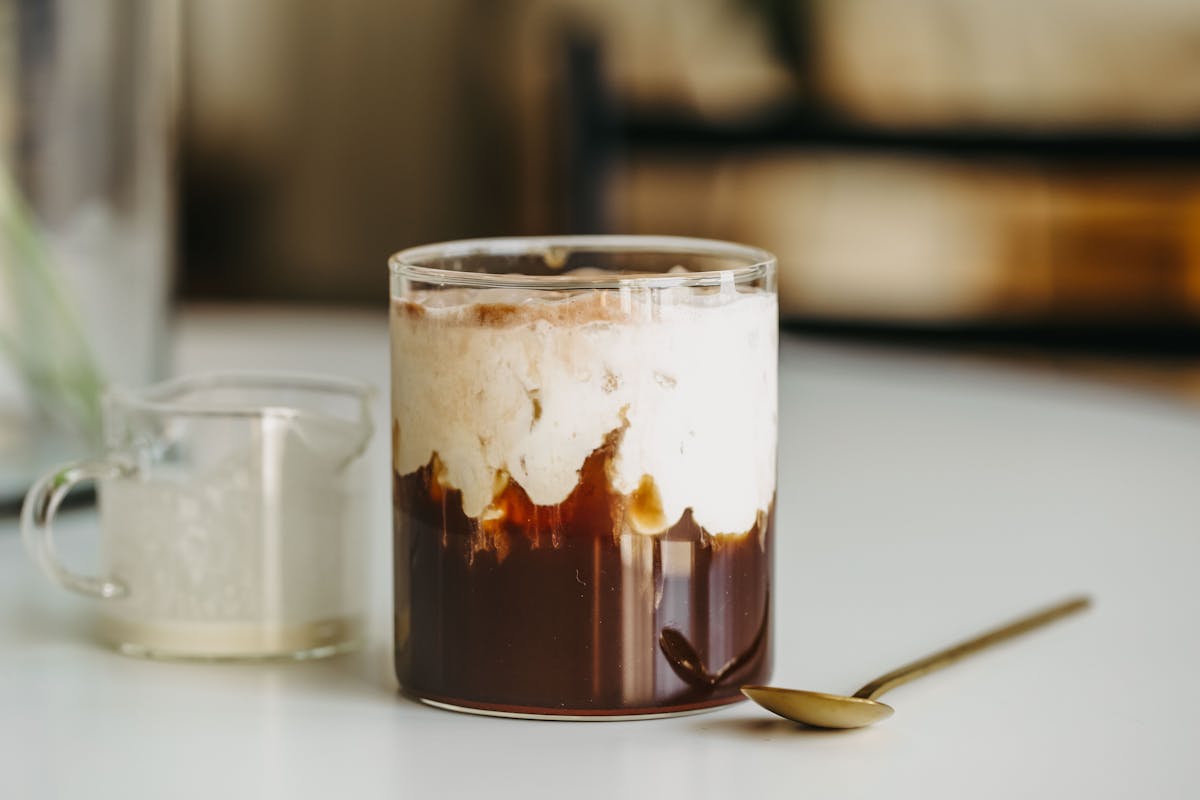
Cold, creamy and delicious - This chocolatey cold brew recipe is the perfect treat to kickstart your morning! The Recipe Chocolate Cream Cold Brew Prep Time: 1 minutes Cook Time: 5 minutes Ingre...
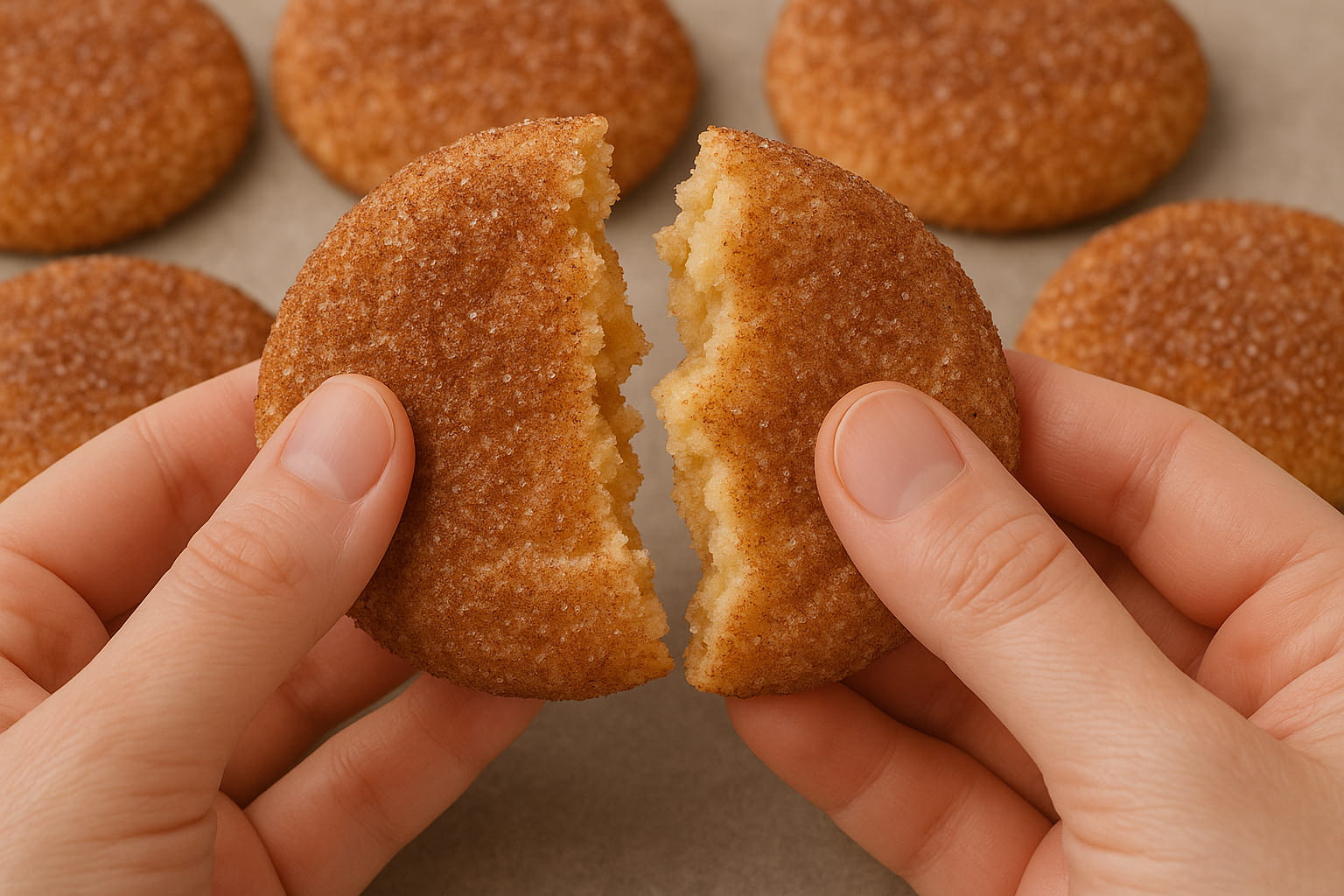
Indulge in the warm embrace of autumn with Pumpkin Spice Snickerdoodles - soft, spiced, and utterly irresistible! The Recipe Pumpkin Spice Snickerdoodles Prep Time: 10 minutes Cook Time: 1 hour ...
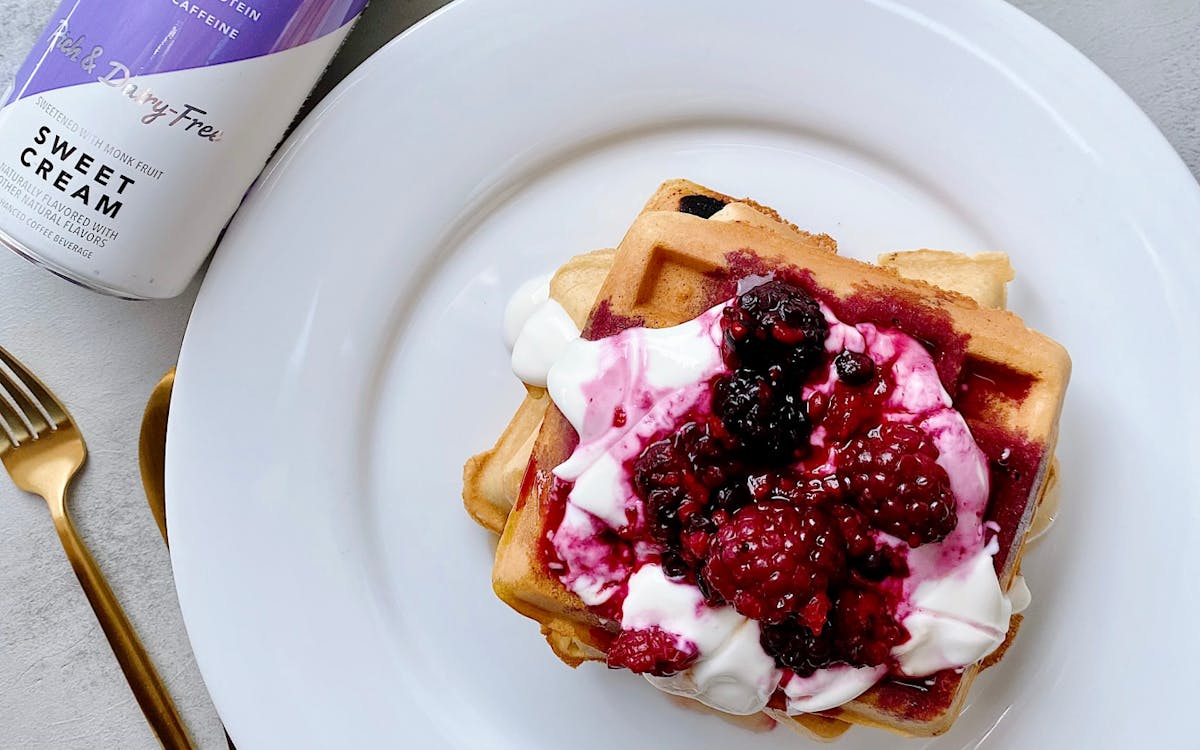
Low Carb Berries & Cream Waffles
These low carb/low sugar waffles are delicious, wonderfully crispy on the outside, and fluffy on the inside. You can also double batch and freeze for easy weekday breakfasts. Featuring our almost-...
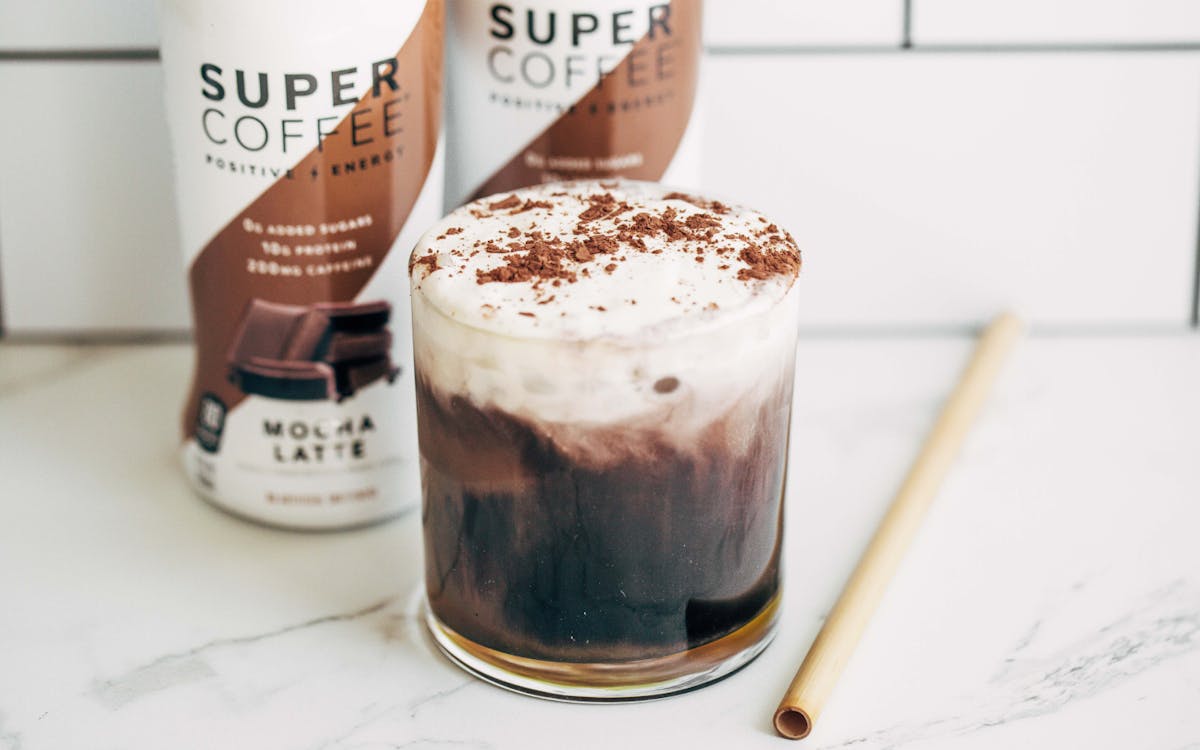
This may be the most fun latte recipe we’ve tried yet! With gooey & decadent black chocolate drizzle and a thick layer of creamy French Vanilla, just one sip of this iced latte will transport ...
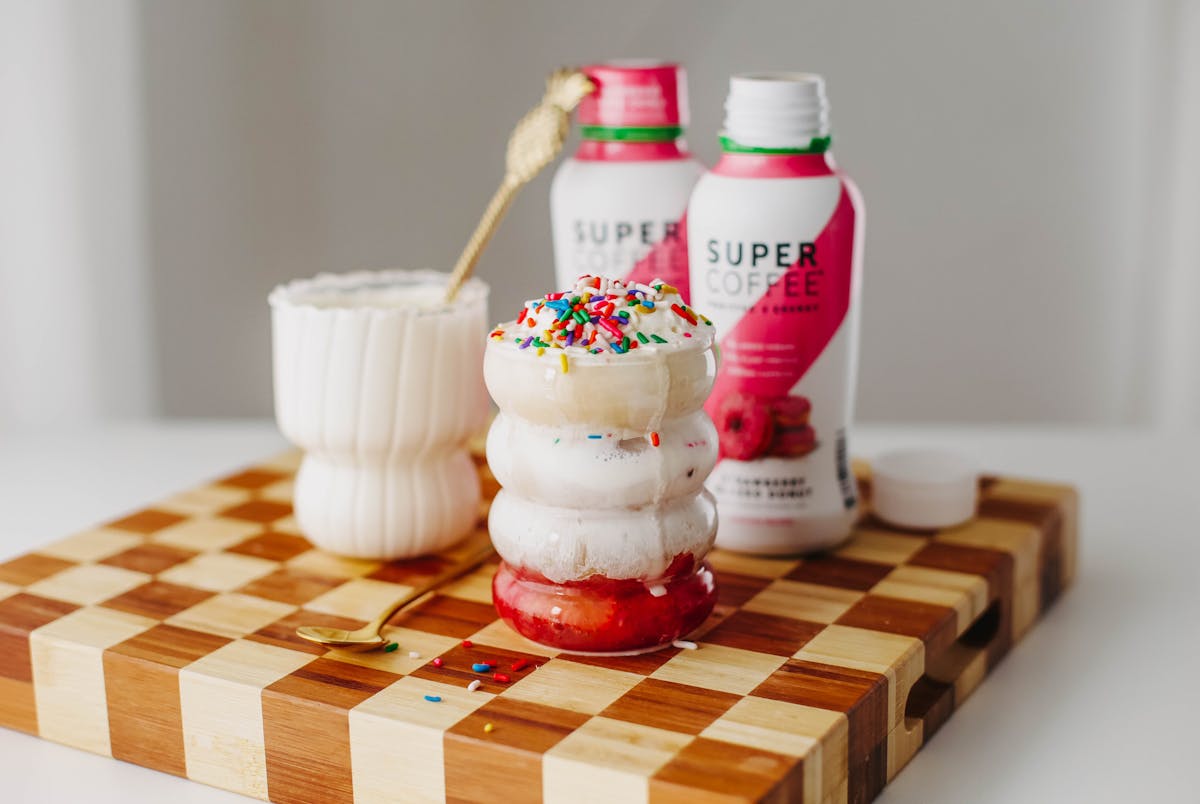
Strawberry Sprinkle Keto Coffee Recipe
Nutritional Info Calories: 274 Fat: 26.7g Carbs: 5.7g Protein: 4.5g Sugar: 2.1g Ingredients 3 strawberries, sliced. 3-4 tbsp heavy cream or half & half. Enough ice to fill a glass. 1/2 cup S...
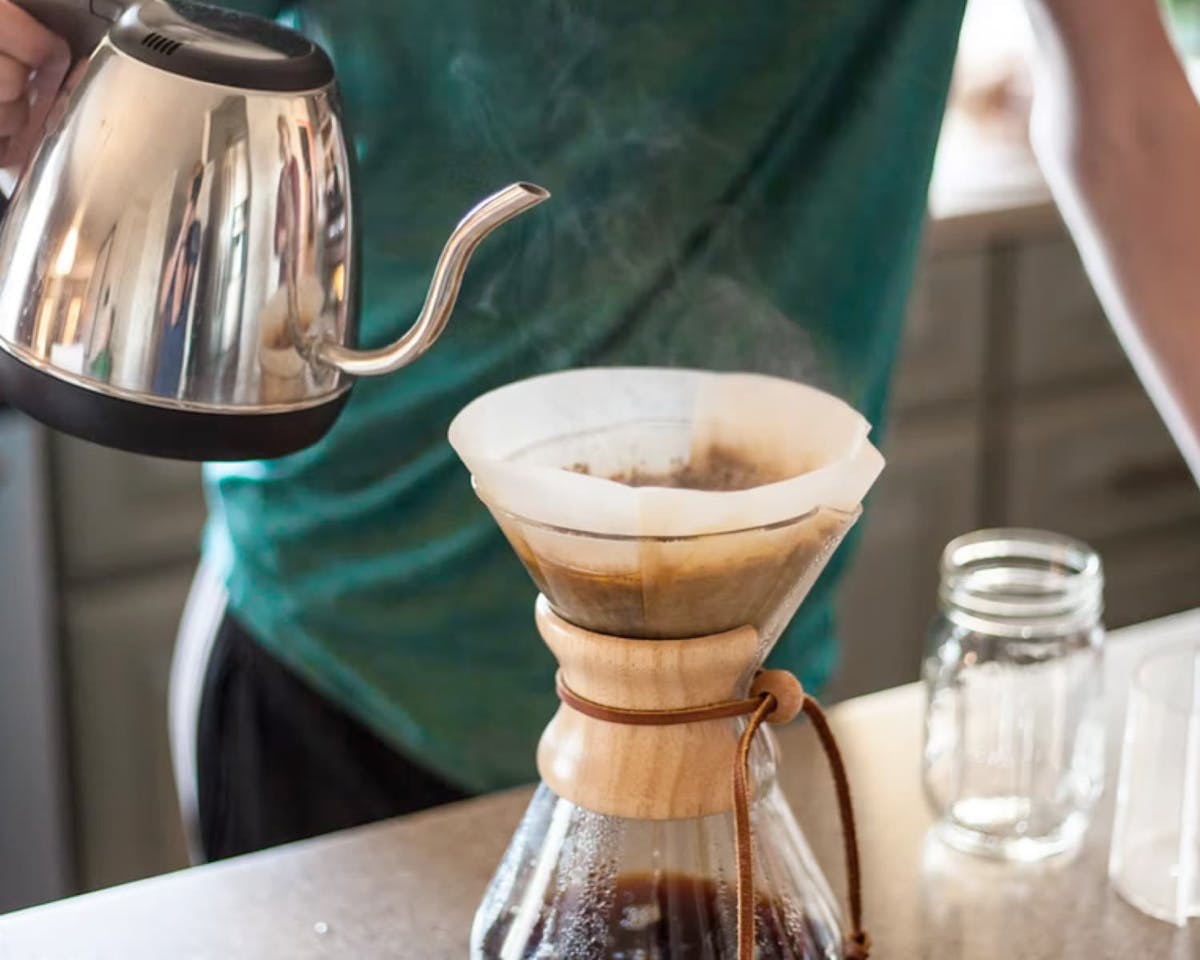
8 Healthy Coffee Recipes That Are Better Than Starbucks
There’s no question about it. Coffee is good for you. Those who don’t like black coffee, of course, commonly add milk, cream and sugar – even if that also means adding calories, fat or carbs to the...



